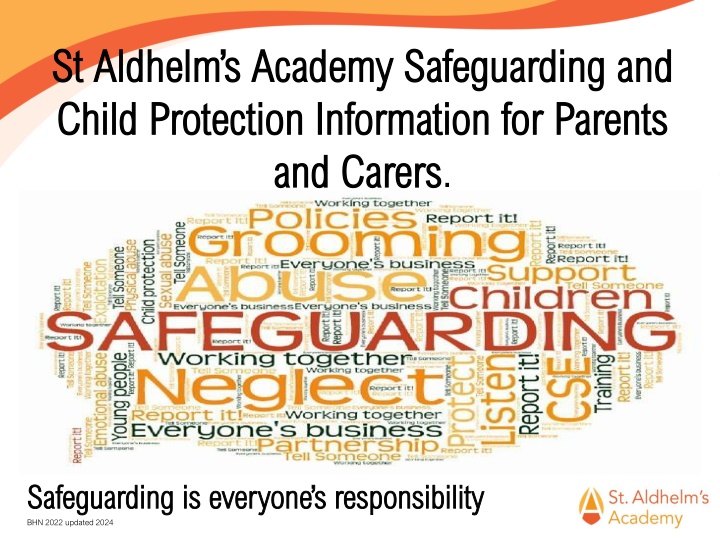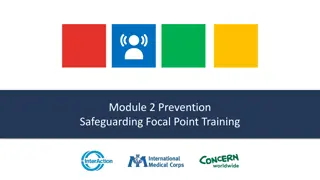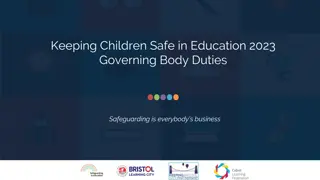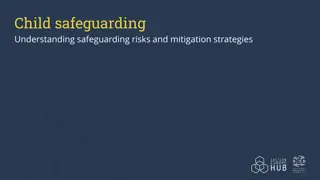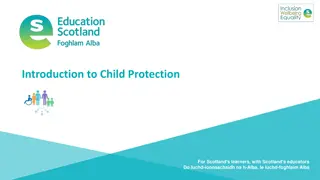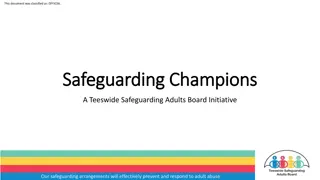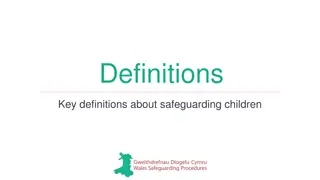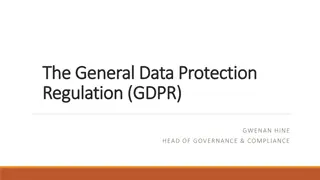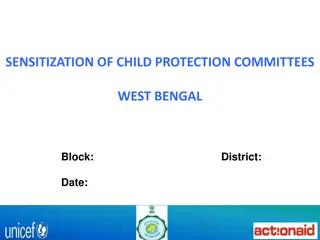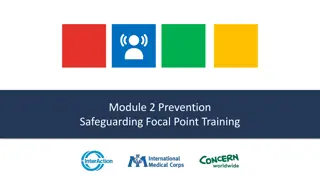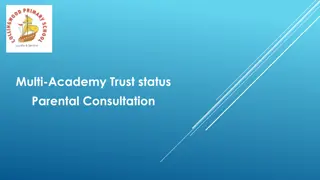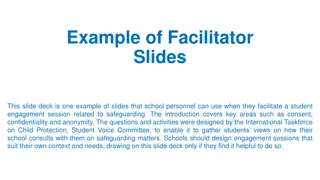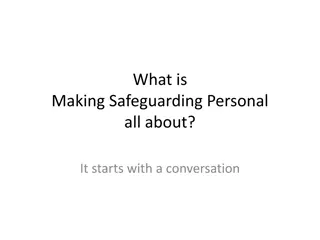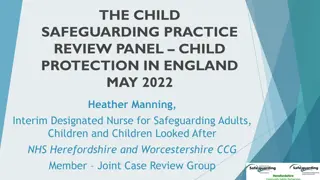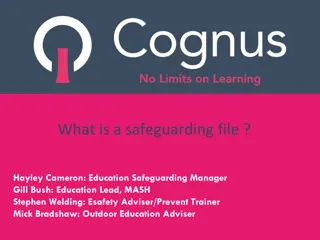St. Aldhelm's Academy Safeguarding and Child Protection Information
St. Aldhelm's Academy provides comprehensive information on safeguarding and child protection for parents and carers. The content covers various types of child abuse, the academy's safeguarding team, policies and documents, and guidance for parents. Safeguarding is emphasized as everyone's responsibility, and resources are available for further support and advice.
Download Presentation

Please find below an Image/Link to download the presentation.
The content on the website is provided AS IS for your information and personal use only. It may not be sold, licensed, or shared on other websites without obtaining consent from the author.If you encounter any issues during the download, it is possible that the publisher has removed the file from their server.
You are allowed to download the files provided on this website for personal or commercial use, subject to the condition that they are used lawfully. All files are the property of their respective owners.
The content on the website is provided AS IS for your information and personal use only. It may not be sold, licensed, or shared on other websites without obtaining consent from the author.
E N D
Presentation Transcript
St St Aldhelm s Aldhelm s Academy Safeguarding and Academy Safeguarding and Child Protection Information for Parents Child Protection Information for Parents and Carers and Carers. Safeguarding is everyone s responsibility Safeguarding is everyone s responsibility BHN 2022 updated 2024
Contents Contents 1.Contents 2.Policies and Documents 3.St Aldhelm s Academy Safeguarding Team 4.What is Child Abuse? 5.What is Neglect? 6.What is Physical Abuse? 7.What is Emotional Abuse? 8.What is Sexual Abuse? 9.What is Child on Child Abuse? 10.What is Domestic Abuse 11.What is County Lines (CE)? 12.What is Child Sexual Exploitation (CSE)? 13.Types of Child Sexual Exploitation 14.Online Safety 15.What is Extremism and Radicalisation? 16.The Prevent Duty 17.What is Self Harm? 18.What is Mental Health? 19.What to do as a parent/carer 20.Further advice and guidance contact details
Policies and Documents Policies and Documents There are a number of policies and documents relating to safeguarding practices at St Aldhelm s Academy. Please speak with a member of the safeguarding team if you would like a copy of these. Policies can be found on our website: staldhelms-academy.co.uk These Include but are not limited to: Keeping Children Safe in Education Working Together to Safeguard Children Guidance for Safer Working Practices What to Do if You are Worried a child is Being Abused Sexual Violence and Sexual Harassment Between Children in Schools and Colleges St Aldhelm s Academy Child Protection& Safeguarding Policy St Aldhelm s Academy Anti Bullying Policy St Aldhelm s Academy Behaviour Policy St Aldhelm s Academy Health and Safety Policy St Aldhelm s Academy Medical First Aid Policy St Aldhelm s Academy Online Safety Policy Lockdown procedures
St Aldhelms Academy Safeguarding Team The staff listed are St Aldhelm s Academy Safeguarding Team, you can talk with any member of staff at the academy if you have any safeguarding and child protection concerns about a child. Safeguarding is everyone's responsibility. Our academy safeguarding Governor is Sharon Moore
What is Child Abuse? What is Child Abuse? There are 4 types of Child abuse: Neglect, Physical Abuse, Emotional Abuse, Sexual Abuse, . There is also Peer on Peer abuse. Abuse can happen to any child regardless of age, gender, race or ability. Child abuse can be a single incident or a number of incidents that have taken place over time and which can cause harm harm to a child Harm as defined by the Children Act 1989 harm harm means ill-treatment or the impairment of health or development of the child including, for example, impairment suffered from seeing or hearing the ill-treatment of another. If ,at any time, St Aldhelm s academy believes there are concerns for the welfare of your child we will discuss this with you. If there are significant concerns where it could cause further harm to the child if we discussed it with you, we will speak directly to children's social care.
What is Neglect? What is Neglect? Neglect is the ongoing failure to meet a child's basic needs and the most common form of child abuse. A child might be left hungry or dirty, or without proper clothing, shelter, supervision or health care. This can put children and young people in danger. It can also have long term effects on their physical and mental wellbeing. Physical neglect-A child's basic needs, such as food, clothing or shelter, are not met or they aren't properly supervised or kept safe. Educational neglect-A parent doesn't ensure their child is given an education. Emotional neglect-A child doesn't get the nurture and stimulation they need. This could be through ignoring, humiliating, intimidating or isolating them. Medical neglect-A child isn't given proper health care. This includes dental care and refusing or ignoring medical recommendations. Some signs to look out for: Some signs to look out for: Poor growth or weight gain or being overweight, poor hygiene, lack of clothing or supplies to meet physical needs, persistently dirty, taking food or money without permission, hiding food for later, poor record of school attendance, persistently tired.
What is Physical Abuse? What is Physical Abuse? Physical abuse is when someone hurts or harms a child on purpose. It includes: hitting with hands or objects slapping and punching kicking shaking throwing poisoning burning and scalding biting and scratching breaking bones drowning. It also includes making up the symptoms of an illness or causing a child to become unwell. Fabricated illness. Some signs to look out for Some signs to look out for: Bruises, broken or fractured bones, burns or scalds bite marks. Children may flinch when others approach them. It can also include other injuries and health problems, such as: scarring, the effects of poisoning, such as vomiting, drowsiness or seizures, breathing problems from drowning, suffocation or poisoning.
What is Emotional Abuse? What is Emotional Abuse? Emotional abuse is any type of abuse that involves the continual emotional mistreatment of a child. It's sometimes called psychological abuse. Emotional abuse can involve deliberately trying to scare, humiliate, isolate or ignore a child. Emotional abuse includes: humiliating or constantly criticising a child threatening, shouting at a child or calling them names, making the child the subject of jokes, or using sarcasm to hurt a child blaming and scapegoating making a child perform degrading acts not recognising a child's own individuality or trying to control their lives pushing a child too hard or not recognising their limitations exposing a child to upsetting events or situations, like domestic abuse or drug taking failing to promote a child's social development not allowing them to have friends persistently ignoring them manipulating a child never showing any emotions in interactions with a child, also known as emotional neglect. Some signs to look out for: Some signs to look out for: Using language you wouldn't expect them to know for their age, act in a way or know about things you wouldn't expect them to know for their age, struggle to control their emotions, have extreme outbursts, seem isolated from their parents lack social skills, have few or no friends.
What is Sexual Abuse? What is Sexual Abuse? When a child is sexually abused, they're forced or tricked into sexual activities. Sexual abuse can happen any where and it can happen in person or online. There are two types of sexual abuse contact and non-contact abuse. Contact abuse is where an abuser makes physical contact with a child. This includes: Sexual touching of any part of a child's body, whether they're clothed or not, using a body part or object to rape or penetrate a child, forcing a child to take part in sexual activities. Making a child undress or touch someone else. Non-contact abuse is where a child is abused without being touched by the abuser. This can be in person or online and includes: Exposing or flashing, showing pornography, exposing a child to sexual acts, making them masturbate. Forcing a child to make, view or share child abuse images or videos. Making, viewing or distributing child abuse images or videos forcing a child to take part in sexual activities or conversations online or through a smartphone. Some signs to look out for: Some signs to look out for: Being withdrawn, change in hygiene, self harm, aggression, insomnia, bed wetting, infections, changes in appearance and dress, Change in performance at school, drinking alcohol, taking drugs, change in attitude.
What is Child on Child Abuse? What is Child on Child Abuse? Children can abuse other children. This is generally referred to as child on child abuse and can take many forms. It can happen both inside and outside of school/college and online. It is most likely to include, but may not be limited to: Bullying (including cyberbullying, prejudice-based and discriminatory bullying); Abuse in intimate personal relationships between peers; Physical abuse; Sexual violence, such as rape, assault by penetration and sexual assault; sexual harassment such as sexual comments, remarks, jokes and online sexual harassment. Non-consensual sharing of nudes and semi nudes images and/or videos; Causing someone to engage in sexual activity without consent; Upskirting; which involves taking a picture under someone s clothing without them knowing; this is usually with the intention of viewing their genitals or buttocks for sexual gratification, or cause the victim humiliation, distress or alarm. Upskirting is a criminal offence and anyone of any gender, can be a victim Initiation/hazing type violence and rituals. Some signs to look out for: Some signs to look out for: Absence from school, truancy or disengagement from school activities, physical injuries, mental or emotional health issues, becoming withdrawn lack of self esteem lack of sleep, alcohol or substance misuse, changes in behaviour, inappropriate behaviour for age, harmful towards others.
What is Domestic Abuse? What is Domestic Abuse? Domestic abuse is defined as an incident or pattern of incidents of controlling, coercive, threatening, degrading and violent behaviour, including sexual violence, in the majority of cases by a partner or ex-partner, but also by a family member or carer. It is very common. In the vast majority of cases it is experienced by women and is perpetrated by men but men can be the victims of domestic abuse. Domestic abuse can include, but is not limited to, the following: Coercive control (a pattern of intimidation, degradation, isolation and control with the use or threat of physical or sexual violence). Psychological and/or emotional abuse Physical or sexual abuse Financial or economic abuse We are an Operation Encompass school. Operation Encompass is a process used to inform schools when the police have attended an incident of domestic violence or abuse, where domestic abuse incidents have occurred in the homes of our pupils.
What is County Lines? What is County Lines? County lines is a form of criminal exploitation in which criminals groom and manipulate children into drug dealing. The 'lines' refer to mobile phones that are used to control a young person who is delivering drugs, often to towns outside their home county. Just like ordering a pizza It doesn t matter where you re from or your social background, children from any community can be groomed into county lines. Children who skip school may be more at risk. Young people aged 14-17 are most likely to be targeted by criminal groups but there are reports of seven year olds being groomed into county lines. County lines can also be refereed to as criminal exploitation(CE) Some Signs to look out for: Some Signs to look out for: Missing school, running away, going missing, staying out late, found in areas away from home, found with drugs on them, found with unexplained mobile phones, unexplained money, using drug related or violent language, unexplained injuries, change of friends, with older people. Taking and making secretive phone calls. Truanting from school.
What is Child Sexual Exploitation What is Child Sexual Exploitation (CSE)? (CSE)? Child sexual exploitation (CSE) is a type of sexual abuse. When a child or young person is exploited they're given things, like gifts, drugs, money, status and affection, in exchange for performing sexual activities. Children and young people are often tricked into believing they're in a loving and consensual relationship. This is called grooming. They may trust their abuser and not understand that they're being abused. Sometimes abusers use violence and intimidation to frighten or force a child or young person, making them feel as if they've no choice. They may lend them large sums of money they know can't be repaid or use financial abuse to control them. Anybody can be a perpetrator of CSE, no matter their age, gender or race. The relationship could be framed as friendship, someone to look up to or romantic. Children and young people who are exploited may also be used to 'find' or coerce others to join groups. Some signs to look out for Some signs to look out for: Unhealthy or inappropriate sexual behaviour, being frightened of some people, places or situations, being secretive, changes in mood or character, aggression, money or things they can't or won't explain, physical signs of abuse, like bruises or bleeding in their genital or anal area, alcohol or drug misuse, sexually transmitted infections, pregnancy, running away, going missing, staying out late, change of appearance, truancy from school, under performing in school.
Types of Child Sexual Exploitation Types of Child Sexual Exploitation CSE can happen in person or online. An abuser will gain a child's trust or control them through violence or blackmail before moving onto sexually abusing them. This can happen in a short period of time. When a child is sexually exploited online they might be persuaded or forced to send or post sexually explicit images of themselves, film or stream sexual activities have sexual conversations. Once an abuser has images, video or copies of conversations, they might use threats and blackmail to force a young person to take part in other sexual activity. They may also share the images and videos with others or circulate them online. Gangs use sexual exploitation: to exert power and control for initiation to use sexual violence as a weapon. Children or young people might be invited to parties or gatherings with others their own age or adults and given drugs and alcohol. They may be assaulted and sexually abused by one person or multiple perpetrators. The sexual assaults and abuse can be violent, humiliating and degrading.
Online Safety Online Safety The internet offers huge opportunities. Children have the chance to learn, research, play games, and have fun. It can also be a very dangerous place as our children can become victims of the Internet It is so important to help them to use the online world in a safe way. Lead by example- Show them how you keep yourself safe online. Ask your child about the apps and websites they use- get them to show you. Reassure them that they can always talk to you- have open conversations with your child about the risks online how to keep themselves safe and who they can report things to. Talk about personal information- not sharing this with anyone online Talk about social media- the risks, people are not always who they say they are. Talk about gaming- this is becoming an increasing concern. Adults who abuse children online are often found hiding behind games online. Talk about cyberbullying- It is important that they talk about this so it can be stopped. Set boundaries - but be realistic You know your child well, and may well recognise it if something is wrong. It s important to act on the warning signs if you start to feel concerned. Have they suddenly become secretive when they are online? People who abuse try to stop children telling their friends or family about the abusive relationship. Are they sad or withdrawn? It maybe that something online is upsetting them, they feel trapped and don t know who to talk to. Are they worried about not being online? This could mean someone is controlling them. Are they planning to meet up with someone they met online?-Offenders may try to persuade a child to meet them in person. They may have convinced them they are in a relationship.
What is Extremism and Radicalisation? What is Extremism and Radicalisation? Extremism is vocal or active opposition to fundamental British values, including democracy, the rule of law, individual liberty and mutual respect and tolerance of different faiths and beliefs Radicalisation is the process through which a person comes to support or be involved in extremist ideologies. It can result in a person becoming drawn into terrorism. How does radicalisation happen? How does radicalisation happen? It may involve being groomed online or in person or exposure to violent material. It happens gradually so children and young people who are affected may not realise what it is that they are being drawn into. Anyone can be radicalised but there are some factors which may make a young person more vulnerable. These could be being easily influenced or impressionable, having low self- esteem or being isolated, feeling rejection, being bullied, discrimination or injustice being Family difficulties, Issues with peers, having a strong need for acceptance or belonging experiencing grief such as loss of a loved one. Indicators of radicalisation Indicators of radicalisation If a child or young person is being radicalised their day-to-day behaviour may become increasingly centred around an extremist ideology, group or cause. For example, they may: spend increasing amounts of time talking to people with extreme views (this includes online and offline communication),change their style of dress or personal appearance lose interest in friends and activities that are not associated with the extremist ideology, group or cause have material or symbols associated with an extreme cause They may try to recruit others to join the cause
The Prevent Duty The Prevent Duty Some organisations in England, Scotland and Wales have a statutory duty, as a specified authority under section 26 of the Counter-Terrorism and Security Act 2015, to identify vulnerable children and young people and prevent them from being drawn into terrorism. This is known as The Prevent duty. These organisations include: Schools Registered childcare providers Local authorities The police Prisons and probation services NHS trusts and foundations.
What is Self Harm? What is Self Harm? Self harm can take lots of physical forms, including cutting burning, bruising, scratching, hairpulling, poisoning, overdosing on medication. Self-harm is when someone hurts themselves as a way of dealing with very difficult feelings, painful memories or overwhelming situations and experiences. Self harm isn t usually a suicide attempt . It is often a way of coping . Some people have described self-harm as a way to express something that is hard to put into words for example to turn invisible thoughts or feelings into something visible, change emotional pain into physical pain, reduce overwhelming emotional feelings or thoughts, have a sense of being in control, escape traumatic memories, punish themselves for their feelings and experiences, stop feeling numb, create a reason to physically care for themselves, or to express suicidal feelings and thoughts without taking their own life. Some physical signs of self harm Some physical signs of self harm Cuts, Bruises, burns, bald patches from hair puling, starvation, Levels of anger and punching walls, Some emotional signs of self harm: Some emotional signs of self harm: Tearfulness, low mood, low motivation, low self esteem, self blame withdrawn, Isolating themselves, unusual eating habits-weight loss or weight gain, Drinking or taking drugs. Talk with your child about their self harm. Stay calm and let them know you are there to support them and keep them safe. Seek advice for you and your child.
What is Mental health What is Mental health We all have mental health, just like we all have physical health. It s about how we think, feel and act. Sometimes we feel well, and sometimes we don t. When our mental health is good, we feel motivated and able to take on challenges and new experiences. But when our mental health is not so good, we can find it much harder to cope. There are lots of reasons why children might start struggling with their mental health. It is usually a direct response to what is going on in their lives. This could be:, life experiences, such as trauma, violence or abuse, physical health problems, pressure at school, difficult relationships with family or friends, family history of mental health problems Often it isn t just one of these things and sometimes there is no obvious cause. Some signs to look out for: Some signs to look out for: feeling hopeless struggling to see the positives in life, or wishing they didn t exist, getting into lots of arguments or fights, feeling sad all the time, feeling angry all the time, feeling anxious all the, not feeling any emotions at all, extreme highs and lows, or mood swings, feeling worthless, changes to their eating patterns starving themselves, over-eating, hearing voices or seeing things that aren t there, hurting themselves on purpose keeping away from friends and family, relying heavily on alcohol, drugs or sex, obsessive behaviour or thoughts feeling there is something they have to do/think about all the time or something bad will happen, experiencing nightmares, flashbacks or upsetting thoughts, obsessing about how they look, constant unwanted thoughts, It is important to reach out for help. This doesn t mean that your child necessarily have a mental health problem, but it s likely that some support will help them on their journey to feeling their best.
What to do as a parent/carer What to do as a parent/carer Parents/carers are the most important people in keeping their children safe. You should always: Feel confident in raising concerns about any child with us. Feel confident in raising concerns about your child with us. Sometimes, concerns cannot be shared with you before Childrens Social Care have become involved. Talk to the school if you need help or support. Let the school know if you have any court orders relating to the safety of your child. Let the school know if there is a change in your circumstances such as house move, a new contact number, change of name , change of parental responsibility. Provide the school with at least two emergency contact numbers. Let the school know if your child for any reason is going to be absent from school.
Where you can go for further advice Where you can go for further advice and guidance and guidance Department for Education - GOV.UK NSPCC- 0808 800 5000 https://www.nspcc.org.uk/ BCP Family Information Directory-https://www.fid.bcpcouncil.gov.uk Your GP surgery or GP Social Services-Children's First Response Hub 01202 123 334 childrensfirstresponse@bcpcouncil.gov.uk . Childline-0800 1111- Childlinehttps://www.childline.org.uk CAMH s-https://www.dorsethealthcare.nhs.uk/.../child-and-adolescent-mental-health- camhs Urgent mental health issue,0800 652 0190 (Freephone) or access via NHS 111 Police -101 or 999 in an emergency- https://www.dorset.police.uk do-it-online Young Minds https://youngminds.org.uk BCP BCHA Domestic Abuse Referrals & Support Line: 01202 710 777 Bournemouth Women s Refuge: 01202 547755 Mankind Initiative for men experiencing/have experienced domestic abuse 01823 334244 The Hideout Website has advice tailored to children and young people who think they are in an abusive relationshiphttp://thehideout.org.uk/
